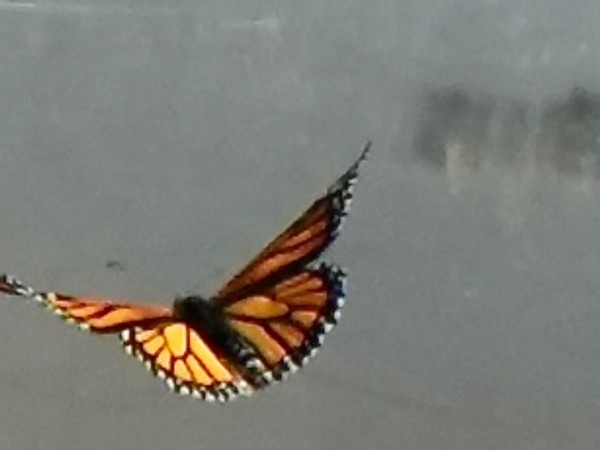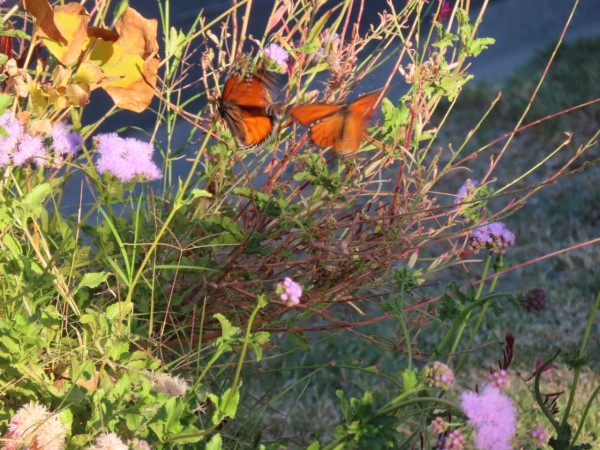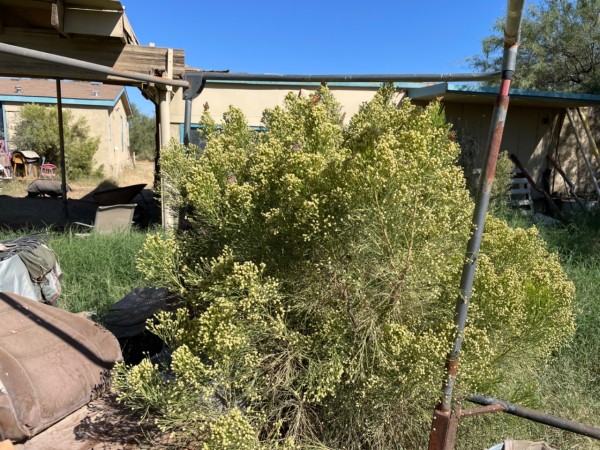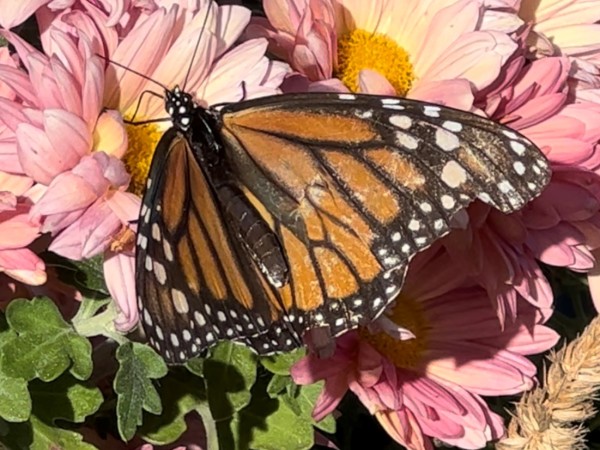Letter From Gail Morris: Western Monarch Fall 2023 Report #5
Western Monarchs Update
Cooler and in some locations wet weather is descending on the monarch migration as they reach their final destinations. Sightings were once again most numerous in California and the deserts of Arizona as they reach the final leg of their journey. Monarchs are increasing at the coastal California overwintering sites and observers are hoping for a large bump in numbers soon.
Recent Sightings
Here is a sample of new sightings this week. Be sure to see the higher density of monarch sightings on the Journey North map.
Katie reported in Goleta, California, reports, on October 25, “65-85 Monarchs hanging from a branch on Eucalyptus tree in the Goleta Monarch Grove.”
Catherine in Galt, California saw one monarch on October 28. “Very windy day NNW w gusts up to 27 mph. Unable to tell if engaging in directional flight.”
Diana in Tucson, Arizona, found one monarch on October 28 visiting in her yard. “Wild male monarch nectaring on Tithonia in my monarch waystation in Tucson, AZ. 2:45 pm at 80 degrees. Fluttering about in tandem with a presumably female monarch.”
Della in Phoenix, Arizona, spotted two monarchs on October 28. “2 of the 5 reported in last post. Both males.”
Rick saw one monarch in Woodland Hills, California on October 27. “In same manzanita as yesterday. Presumably same individual. I have only seen 5 Monarchs in my yard in 5 years so two days in row unusual.”
Michael reported twelve monarchs in Picture Rock, Arizona on October 23. “About 5 adult monarchs are in this picture. They have been here several days now. I have seen others on other desert broom bushes.”
Reports from the Field
Pacific Grove, California
News from Stephanie Turcotte at Pacific Grove, California:
“Counting monarchs often does take your breath away! This morning was exceptionally stunning. It was cool in the grove; however, the monarchs have re-positioned themselves to receive the early morning sun in the southern end of the habitat and mostly on branches either overhanging the fence and into the neighbors’ yards or on trees located there. While they are beginning to cluster on a few of the Monterey pines that were utilized along the path in the grove last year, the majority are along the perimeter. We had our first rain about a week ago, so that may be a contributing factor to their move.
“Our final count this morning 10/27/23 was 3,370 monarchs spread among 23 trees. 2,484 of that number were on that south side I described. On one, young, Monterey pine in the neighbor’s yard, there were 450 monarchs alone.
“Some of the other wildlife in the grove, at times, make it a challenge to count a cluster before some monarchs disperse due to disturbance. Like this morning, we watched several monarchs fly off as a honey bee flew onto a Eucalyptus branch. Fortunately, it didn’t disturb the entire cluster. We just hold our breath when that happens and hope that it’s only a few that fly.
“We haven’t had our big jump yet, like we did in 2021 (11,213 10/28/21) and 2022 (9,544 10/29/22) at this time, but I feel like it’s coming.”
Santa Cruz, California
Diana Magor shares her monitoring reports at these two important sights in Santa Cruz, California.
“My survey at Lighthouse Field today resulted in a count of 3,556, with 2,072 on 2 Monterey Cypress inside the grove, 1,394 on an East facing cypress near the eastern periphery and only 90 on the Blue Gum Eucalyptus at the viewing area. Mostly males. Several monarchs in surveys 2 weeks ago here and recently at Pacific Grove were quite small, but I did not see many small ones today. The temp was 53°F, sunny, with a fairly strong breeze out of the North.
“Natural Bridges reportedly has a similar count, and John Dayton found a tagged monarch from a David James citizen scientist in the PNW there recently.
“There have been many monarchs seen in people’s gardens during the daytime, 5 at one time in mine yesterday. Ovipositing, mating and nectaring continue. Attached is a photo of a female nectaring on a pink chrysanthemum in my home Waystation. She deposited an egg on a Heartleaf milkweed, then quickly nectared from 3 different species.”
Thank You!
A special Thank You to Stephanie Turcotte and Diana Magor for their reports. We will be waiting to see how the monarch numbers grow in November as the annual Thanksgiving Count grows near.
Send in your reports!
Keep your eyes to the sky looking for monarchs as they reach the final stages of their fall journey. If you are out this week and see monarchs of any life stage, be sure to report them to Journey North—whether they are adults, eggs or larvae. Provide as much information as you can such as weather conditions (it’s okay to estimate). Your detailed description of what you see can include, but is not limited to, the monarch’s gender and activity and, if known, the type of flowers if they are nectaring.
Gail Morris is the Coordinator of the Southwest Monarch Study (www.swmonarchs.org), a Monarch Watch Conservation Specialist, and the Vice President of the Monarch Butterfly Fund, the Central Arizona Butterfly Association, and the Western Monarch Advocates. The Western Monarch Population News is based on comments provided to Gail Morris. We hope to increase the number of sightings and therefore photos and comments entered into the Journey North. We rely on the volunteers who communicate regularly with Gail and who agree to participate in our effort to increase awareness of the population of Western Monarchs. You can reach her at gail@swmonarchs.org







